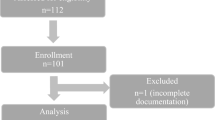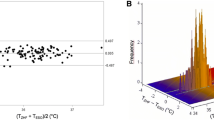Abstract
Objective. Our objective was to study the effect of the temperature of the anesthetic gas mixture (AGM) on esophageal temperature measurements made in children whose tracheas had been intubated for anesthesia. We also sought to establish the optimal site for the temperature sensor in the esophagus and to find a way to accurately place the sensor.Methods. Special esophageal temperature probes with thermistors located at 1-cm intervals were used for data collection on a multiplex system. Esophageal temperature measurements were made every 15 minutes for a period of 120 minutes in anesthetized children receiving heated (n=30) and unheated (n=30) anesthetic gases.Results. The temperature of the AGM (p<0.001), the site of measurement (p<0.001), and the interaction between AGM temperature and site of measurement (p<0.007) all had a significant effect on esophageal temperature measurements. This effect was greatest at a point 3 cm distal to the level of the tip of the endotracheal tube when AGMs were not heated.Conclusion. We conclude that best results are obtained when care is taken to place the thermistor in the lower quarter of the esophagus. (We provide a simple formula for calculating this placement in pediatric patients of varying ages.) Placing the probe by acoustic criteria cannot consistently be relied on to provide good thermometry.
Similar content being viewed by others
References
Bissonnette B, Sessler DI. Passive or active inspired gas humidification increases thermal steady state temperatures in anesthetized infants. Anesth Analg 1989;69:893–897
Bloch EC, Ossey KD, Ginsberg B. Tracheal intubation in children. A new method for assuring correct depth of tube placement. Anesth Analg 1988;67:791–793
Brengelmann GL, Johnson JM, Hong PA. Electrographic verification of esophageal temperature probe position. J Appl Physiol 1979;47:638–642
Davis PJ. Temperature regulation in infants and children. In: Motoyama EK, Davis PJ, eds. Anesthesia for infants and children. Philadelphia: Mosby, 1990:143–156
Cork RC, Vaughan RW, Humphrey LS. Precision and accuracy of intraoperative temperature monitoring. Anesth Analg 1983;62:211–214
Whitby JD, Dunkin LJ. Temperature differences in the oesophagus; a preliminary study. Br J Anaesth 1968;40:991–995
Whitby JD, Dunkin LJ. Temperature differences in the oesophagus. The effects of intubation and ventilation. Br J Anaesth 1969;41:615–618
Bissonnette B, Sessler DI, La Flamme P. Intraoperative temperature monitoring sites in infants and children and the effect of inspired gas warming on esophageal temperature. Anesth Analg 1989;69:192–196
Freund PR, Brengelmann GL. Placement of esophageal stethoscope by acoustic criteria does not consistently yield an optimal location for the monitoring of core temperature. J Clin Monit 1990;6:166–270
Whitby JD, Dunkin LJ. Cerebral, oesophageal and nasopharyngeal temperatures. Br J Anaesth 1971;43:673–676
Brengelmann GL. Dilemma of body temperature measurement. In: Shiraki J, Yousef MI, eds. Man in stressful environments. Springfield, IL: Charles C. Thomas, 1988:5–22
Holdcroft A, ed. Body temperature control in anaesthesia, surgery and intensive care. London: Bailliere Tindall, 1980:41–73
Cooper KE, Kenyon JR. A comparison of temperatures measured in the rectum, oesophagus, and on the surface of the aorta during hypothermia in man. Br J Surg 1957;44:616–619
Whitby JD, Dunkin LJ. Oesophageal temperature differences in children. Br J Anaesth 1970;42:1013–1015
Stroebel CT, Byrne WJ, Ament ME, Euler AR. Correlation of esophageal lengths in children with height: application to the Tuttle test without prior esophageal manometry. J Pediatr 1979;94:81–84
Author information
Authors and Affiliations
Additional information
Supported in part by a grant of equipment and financial assistance from Mallinckrodt Medical, Inc, St Louis, MO.
Rights and permissions
About this article
Cite this article
Bloch, E.C., Ginsberg, B. & Binner, R.A. The esophageal temperature gradient in anesthetized children. J Clin Monitor Comput 9, 73–77 (1993). https://doi.org/10.1007/BF01616917
Received:
Revised:
Accepted:
Issue Date:
DOI: https://doi.org/10.1007/BF01616917




